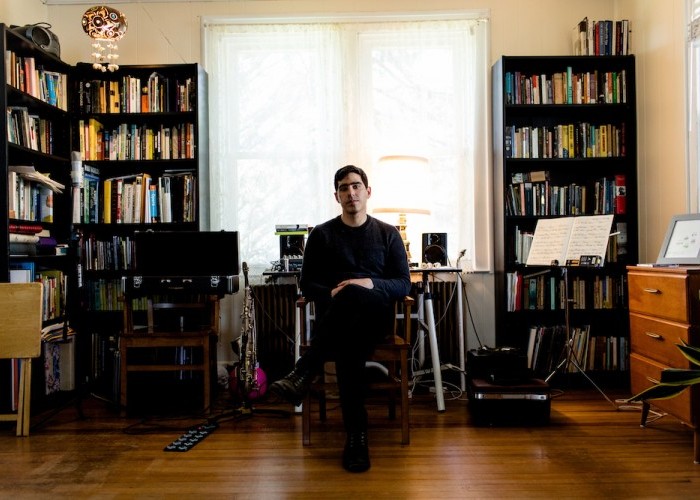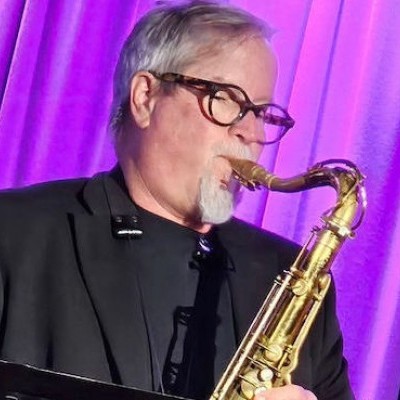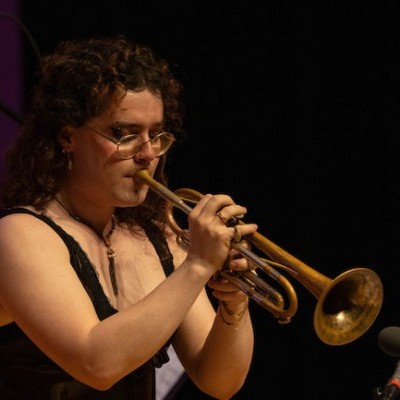Oct 28, 2025 10:47 AM
In Memoriam: Jack DeJohnette, 1942–2025
Jack DeJohnette, a bold and resourceful drummer and NEA Jazz Master who forged a unique vocabulary on the kit over his…

Andrew Bernstein, who also performs with Baltimore avant-rock act Horse Lords, has issued a solo saxophone recording, An Exploded View Of Time (Hausu Mountain).
(Photo: Justin Tsucalas)Baltimore-based multi-instrumentalist Andrew Bernstein delivers a truly unique and transcendent solo recording with An Exploded View Of Time (Hausu Mountain).
As the director of Goucher College’s graduate-level Art & Technology program, Bernstein teeters between his extensive knowledge of digital and electronic music, and an artistic connection to his alto saxophone, an instrument that drones and cascades notes, propelled by his mastery of circular breathing. The compositions on An Exploded View Of Time each set a distinct mood, often utilizing ostinato figures, polyrhythms and extended polytonal techniques, developing over the length of each piece, constantly shifting in shade and timbre.
Bernstein’s background in music is broad—apart from his solo practice, the saxophonist performs with avant-rock act Horse Lords, which has issued three full-lengths and toured extensively in the States and abroad.
In a chat with DownBeat, Bernstein discusses how this latest album came about, the random happenstance of choosing to play saxophone and recording solo music.
The following has been edited for length and clarity.
How do you balance your background in electronic music while playing an acoustic instrument and making minimal music?
I studied electronic music and digital music. When I started playing the saxophone, I’d already been making electronic music for a few years, and I almost wanted to emulate some of the aspects of electronic music that I was working with. I was getting very into the repetitive brand of minimalist music, and the stark droning kind. Wanting to emulate that drew me to the circular breathing technique, so I could sustain notes and repeated patterns. I was also interested in micro-acoustic changes in the timbre of the saxophone that sounds like a filter-sweep on a synthesizer.
So, I feel like my experience working with electronics really informs my acoustic saxophone playing.
How did you learn circular breathing?
I became aware that it was possible for instrumentalists to do, and through my experience working with synthesizers, I was pushed to [learn] how to sustain tones on the saxophone endlessly. But [in the beginning], I couldn’t do it, because I had to breathe. I looked up how to do it on the internet, and it’s kind of like riding a bike, in that before you know how to ride a bike, it seems insane. How do you balance on two wheels? Then, eventually, it physically clicks, and then you go, “Oh, that’s how you do it.”
From there, it took a lot of practice for me to feel comfortable that I could write music that relied on the technique and be able to go out and perform it.
Why didn’t you bring in other players to collaborate for the new album?
This isn’t my first solo record. Since I started making music as a teenager, I’ve been making solo music by multitracking guitars and drums, and as I became more of a woodwind player, and continued making electronic compositions, I felt like my effects on playing were getting to a place where I really wanted to make a solo saxophone record.
I sit at home and I play saxophone by myself and I was developing this music out of that practice. So, putting out music under my own name, rather than with a group is something I’m comfortable with and have a history of doing, in addition to working with Horse Lords.
How’d you settle on saxophone as your main instrument?
It’s all pretty circumstantial. I grew up playing the clarinet, because my older brother played. So, he brought home the clarinet, and I became infatuated with it, and would borrow it and taught myself to play it a little bit.
I played in concert band growing up, and my brother eventually switched to saxophone, so I got the clarinet and played through primary school and some in college. But in high school, I started to want to play in rock bands with my friends, and there wasn’t much room for a clarinet in a rock band. So, I play a lot of guitar as well. But then toward the end of college, I started playing saxophone, which was circumstantial as well.
My college roommate had a saxophone laying around, and he lent it to me. At the time, I was getting more into experimental music and was in noise bands. Because the clarinet was so quiet [it didn’t quite fit]. So, the sax seemed to work much better, because it’s a louder instrument; it wasn’t a deliberate decision.
Can you explain the pulsing polyrhythmic sound on An Exploded View Of Time?
Maybe there’s less polyrhythm on this album than a [Horse Lords album]. But I see that kind of stuff coming more from a ritualistic, transcendental place.
I feel like polyrhythm has a psycho-physical component, where your body feels multiple beats going at once, and it sort of puts you off balance in a satisfying way, at least for me. I think about that when I think about what abstract music means. It’s sort of like having multiple lines going at once, and this is something I try to achieve: polyphony with a monophonic instrument. DB

Jack DeJohnette boasted a musical resume that was as long as it was fearsome.
Oct 28, 2025 10:47 AM
Jack DeJohnette, a bold and resourceful drummer and NEA Jazz Master who forged a unique vocabulary on the kit over his…

“I’ve told students, ‘I don’t mind if you use AI for this or that project,’” says MIT’s Pascal Le Boeuf. “‘But you need to tell me.’”
Sep 18, 2025 11:14 AM
A standard joke when it comes to discussing artificial intelligence, or AI, is that it’s developing so rapidly that…

Chuck Manning Works for NASA … and plays jazz.
Sep 18, 2025 11:23 AM
Congratulations! After years of study, you’ve earned your degree in jazz performance. But let’s face it: Making a…

Always a sharp dresser, Farnsworth wears a pocket square given to him by trumpeter Art Farmer. “You need to look good if you want to hang around me,” Farmer told him.
Sep 23, 2025 11:12 AM
When he was 12 years old, the hard-swinging veteran drummer Joe Farnsworth had a fateful encounter with his idol Max…

“Make time and energy to meet people and make friends,” suggests Millie Ahearn, a student at DePaul University.
Sep 18, 2025 11:32 AM
For many students, the transition into a collegiate jazz program can feel overwhelming — new peers, unfamiliar…